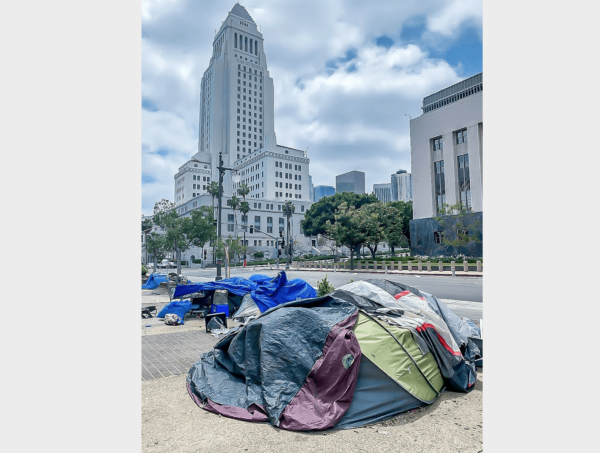By Jose Herrera
The Los Angeles City Council directed various city departments Wednesday to conduct a review of the effectiveness and financial cost of the city’s anti-camping law aimed at restricting the location of homeless encampments.
A motion presented by council members Katy Yaroslavksy and Curren Price and approved unanimously calls for a report on the application, enforcement and effectiveness of the law, known as section 41.18, which bans sitting, sleeping and storing property near an estimated 2,000 designated sites in the city.
“I understand that this is a sensitive issue, and I respect that each one of us has different opinions on the use of 41.18 as a tool in our efforts to end homelessness,” Yaroslavksy said. “I’ve stated before that I agree there are certain locations such as school and daycare centers that should be covered by the law.
“There are some who believe we should go further and some who believe that those sites shouldn’t exist at all. But while our opinions on 41.18 may differ, the means by which we enforce them should not.”
Shortly after the city passed 41.18, the council approved the Street Engagement Strategy, a component of the outreach engagement framework, which outlined required steps prior to the enforcement of the law. The Street Engagement Strategy offered an opportunity for the city and its partners to provide housing resources to individuals impacted by the law, though its effectiveness has not yet been fully analyzed.
Yaroslavksy said the motion would “shine a light” on how the enforcement of 41.18 has been carried out by requesting a report on several key metrics of the law including, but not limited to, a breakdown of the total cost of enforcement with details on the staff cost, and the price of anti-camping signage, which she noted has cost the city several million dollars.
“The reality is that we don’t have a clearer picture as to how 41.18, specifically as it relates to individual sites determined through council motion, has been applied and whether or not its reducing homelessness. That is a problem,” Yaroslavksy said.
Following the council’s vote, Councilman Hugo Soto-Martínez, who opposed 41.18, posted on Twitter that he would be looking forward to the report examining the law’s efficacy.
“LA’s Municipal Code 41.18 criminalizes unhoused people, preventing them from existing in large portions of the city, even as we don’t have nearly enough housing or shelter beds to accommodate everyone forced to live on our streets,” Hugo-Martínez wrote in a Twitter post.
The law prohibits sitting, sleeping, lying and storing personal property within two feet of any fire hydrant or fire plug; within five feet of any operational or utilizable entrance or exit; within 10 feet of a loading dock or driveway; in a manner that interferes with any activity for which the city has issued a permit or restricts accessible passage as required by the Americans with Disabilities Act; or anywhere within a street, including bike paths.
The law also prohibits encampments within 500 feet of a “sensitive” facility including schools, day care facilities, parks and libraries.
Other affected areas include:
— within 500 feet of a designated overpass, underpass, freeway ramp, tunnel, bridge, pedestrian bridge, subway, wash or spreading ground, railroad track or where lodging unsheltered or in tents is unhealthy, unsafe and incompatible with safe passage; and
— within 1,000 feet of a facility opened after Jan. 1, 2018, that provides shelter, safe sleeping, safe parking or navigation centers for people experiencing homelessness.
The ordinance allows the city to prevent encampments for a period of no longer than one year in areas that are deemed an ongoing threat to public health or safety, including due to:
— death or serious bodily injury of any person at the location due to a hazardous condition;
— repeated serious or violent crimes or threats of serious or violent crimes, including human trafficking; and
— fires at the location. The street engagement strategy also includes frameworks to conduct engagement during emergencies, including national disasters and public health matters.







